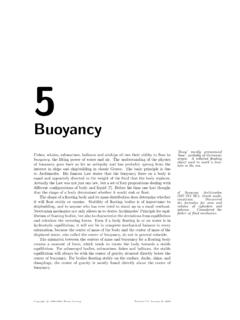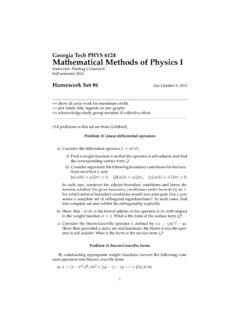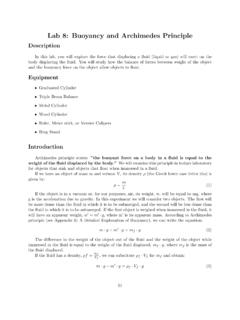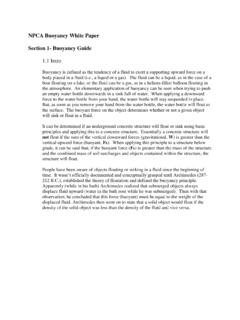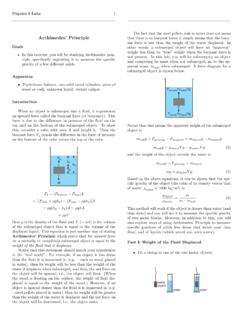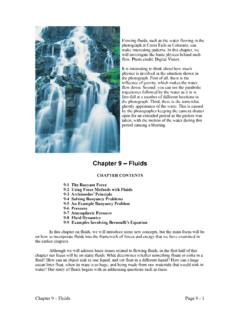Transcription of Buoyancy and stability - Georgia Institute of Technology
1 3 Buoyancy and stability Buoy mostlypronounced booe , probably of Germanicorigin. A tethered floating objectused to mark a location in , whales, submarines, balloons and airships all owe their ability to float tobuoyancy, thelifting power of water and air. The understanding of the physics of Buoyancy goes back as faras antiquity and probably sprung from the interest in ships and shipbuilding in classic basic principle is due to archimedes . His famous Law states that the Buoyancy force on abody is equal and oppositely directed to the weight of the fluid that the body displaces. Beforehis time it was thought that the shape of a body determined whether it would sink or of Syracuse (287 212 BC).Greek mathematician,physicist and the formulae for areaand volume of cylinders andspheres, and invented rudimen-tary infinitesimal calculus.
2 For-mulated the Law of the Lever,and wrote two volumes on hydro-statics titledOn Floating Bodies,containing his Law of by a Roman shape of a floating body and its mass distribution do, however, determine whether itwill float stably or capsize. stability of floating bodies is of vital importance to shipbuilding and to anyone who has ever tried to stand up in a small rowboat. Newtonian mechanicsnot only allows us to derive archimedes Law for the equilibrium of floating bodies, but alsoto characterize the deviations from equilibrium and calculate the restoring forces. Even if abody floating in or on water is in hydrostatic equilibrium, it will not be in complete mechanicalbalance in every orientation, because the center of mass of the body and the center of mass ofthe displaced water, also called the center of Buoyancy , do not in general mismatch between the centers of mass and Buoyancy for a floating body creates amoment of force, which tends to rotate the body towards a stable equilibrium.
3 For submergedbodies, submarines, fishes and balloons, the stable equilibrium will always have the center ofgravity situated directly below the center of Buoyancy . But for bodies floating stably on thesurface, ships, ducks, and dumplings, the center of gravity is mostly found directlyabovethecenter of Buoyancy . It is remarkable that such a configuration can be stable. The explanationis that when the surface ship is tilted away from equilibrium, the center of Buoyancy movesinstantly to reflect the new volume of displaced water. Provided the center of gravity does notlie too far above the center of Buoyancy , this change in the displaced water creates a momentof force that counteracts the archimedes principleMechanical equilibrium takes a slightly different form than global hydrostatic equilibrium( ) on page 27 when a body of another material is immersed in a fluid.
4 If its material isincompressible, the body retains its shape and displaces an amount of fluid with exactly thesame volume. If the body is compressible, like a rubber ball, the volume of displaced fluidwill be smaller. The body may even take in fluid, like a sponge or the piece of bread you dunkinto your coffee, but we shall disregard this possibility in the 1998 2010 Benny Lautrup42 PHYSICS OF CONTINUOUS MATTERA body which is partially immersed with a piece inside and another outside the fluid mayformally be viewed as a body that is fully immersed in a fluid with properties that vary fromplace to place. This also covers the case where part of the body is in vacuum which may bethought of as a fluid with vanishing density and and Buoyancy 6@@I AAU@ pulls on a body overits entire volume while pressureonly acts on the the actual, perhaps compressed, volume of the immersed body beVwith surfaceS.
5 Inthe field of gravity an unrestrained body with mass density bodyis subject to two forces: itsweightFGDZV bodygdV;( )and the Buoyancy due to pressure acting on its surface,FBD ISpdS:( )If the total forceFDFGCFB does not vanish, an unrestrained body will accelerate inthe direction ofFaccording to Newton s Second Law. Therefore, in mechanical equilibriumweight and Buoyancy must precisely cancel each other at all times to guarantee that the bodywill remain in body partially submerged ina amount of water that hasbeen displaced by the body be-low the waterline. In equilibriumthe weight of the displaced fluidequals the weight of the that the body does not itself contribute to the field of gravity, the local balanceof forces in the fluid, expressed by eq.
6 ( ) on page 28, will be the same as before the bodywas placed in the fluid. In particular the pressure in the fluid cannot depend on whether thevolumeVcontains material that is different from the fluid itself. The pressure acting on thesurface of the immersed body must for this reason be identical to the pressure on a body offluid of the same shape, but then the global equilibrium condition ( ) on page 27 for anyvolume of fluid tells us thatFfluidGCFBD0, orFBD FfluidGD ZV fluidgdV:( )This theorem is indeed archimedes principle: the force of Buoyancy is equal and opposite to the weight of the displaced total force on the body may now be writtenFDFGCFBDZV. body fluid/gdV;( )explicitly confirming that when the body is made from the same fluid as its surroundings so that bodyD fluid the resultant force vanishes automatically.
7 In general, however, thedistributions of mass in the body and in the displaced fluid will be vonM unchhausen(1720 1797).German soldier,hunter, nobleman, and delightfulstory-teller. In one of his stories,he lifts himself out of a deep lakeby pulling at his unchhausen effect: archimedes principle is valid even if the gravitational field variesacross the body, but fails if the body is so large that its own gravitational field cannot be neglected,such as would be the case if an Earth-sized body fell into Jupiter s atmosphere. The additionalgravitational compression of the fluid near the surface of the body generally increases the fluiddensity and thus the Buoyancy force. In semblance with Baron von M unchhausen s adventure, thebody in effect lifts itself by its bootstraps (see problems and ).
8 Copyrightc 1998 2010 Benny Lautrup3. Buoyancy AND STABILITY43 Constant field of gravityIn a constant gravitational field, , everything simplifies. The weight of the bodyand the Buoyancy force become instead,FGDM bodyg0;FBD Mfluidg0:( )Since the total force is the sum of these contributions, one might say that Buoyancy acts as ifthe displacement were filled with fluid of negative mass Mfluid. In effect the Buoyancy forceacts as a kind of total force on an unrestrained object is now, Mfluid/g0:( )If the body mass is smaller than the mass of the displaced fluid, the total force is directedupwards, and the body will begin to rise, and conversely if the force is directed downwards itwill sink. Alternatively, if the body is kept in place, the restraints must deliver a force Ftoprevent the object from constant gravity, a body can only hover motionlessly inside a fluid (or on its surface) ifits mass equals the mass of the displaced fluid,MbodyDMfluid:( )A fish achieves this balance by adjusting the amount of water it displaces (Mfluid) throughcontraction and expansion of its body by means of an internal air-filled bladder.
9 A submarine,in contrast, adjusts its mass (Mbody) by pumping water in and out of ballast Triangle Mystery:It has been proposed that the mysterious disappearance ofships near Bermuda could be due to a sudden release of methane from the vast deposits of methanehydrates known to exist on the continental shelves. What effectively could happen is the same aswhen you shake a bottle of soda. Suddenly the water is filled with tiny gas bubbles with a densitynear that of air. This lowers the average density of the frothing water to maybe only a fraction ofnormal water, such that the mass of the ship s displacement falls well below the normal value. Theship is no more in buoyant equilibrium and drops like a stone, until it reaches normal density wateror hits the bottom where it will usually remain forever because it becomes filled with water on theway down.
10 Even if this sounds like a physically plausible explanation for the sudden disappearanceof surface vessels, there is no consensus that this is what really happened in the Bermuda Triangle,nor in fact whether there is a mystery at all [4].The physical phenomenon is real enough. It is, for example, well known to white water sailorsthat holes can form in which highly aerated water decreases the Buoyancy , even to the pointwhere it cannot carry any craft. You can yourself do an experiment in your kitchen using a half-filled soda bottle with a piece of wood floating on the surface. When you tap the bottle hard, carbondioxide bubbles are released, and the ship sinks. In this case the ship will however quicklyreappear on the [Gulf stream surface height]:The warm Gulf stream originates in the Gulfof Mexico and crosses the Atlantic to Europe after having followed the North American coast toNewfoundland.
